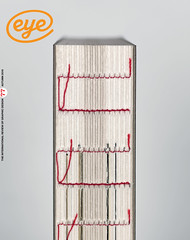Autumn 2010
Nuffin’ like a Puffin
Puffin by Design: 70 Years of Imagination 1940-2010
Puffin by Design: 70 Years of Imagination 1940-2010, By Phil Baines, Penguin, £20Phil Baines’s Penguin by Design: A Cover Story (2005) was, even at a glance, a marvellous coffee-table book, stuffed to the gills with reproductions of gorgeous and ingenious cover designs from Penguin’s seven decades of publishing. It was also a superb synthesis of criticism and corporate history (not kinds of writing that sit easily together); all in all, deeply pleasing as well as essential reading.
In Puffin by Design, Baines applies himself to the history of Penguin’s children’s imprint, which began five years after the main business. The book follows the same plan as its predecessor – a broad chronological sweep in five chapters – and is in the same format (the flyleaf says it is designed by Tom Sanderson, based on Penguin by Design, designed by David Pearson, see pp.64-71). It also has the same qualities of intelligence and taste, but the two books differ in significant ways.
The first is that Penguin by Design was largely concerned with typography and branding, the two things being closely related: for the first 25 years of the company’s existence, Penguin eschewed illustration in favour of the starkness of Gill sans, flat planes of colour, and the stylised Penguin logo. Even after cover illustrations became the norm, they sat within strict formats depicted by the demands of typographical consistency; it was only in the late 1970s that Penguin covers broke free.
By contrast, Puffin by Design is mainly about illustration, always a more important element of children’s books. Puffins began in 1940 as a series of picture books – the idea was sold to Allen Lane by Noel Carrington, who had been inspired by educational Russian books and Père Castor in France. Picture Puffins were being published well into the 1970s. The standard of illustration was often extremely high, and the pages devoted to covers and spreads from the early years of this series are the most purely delightful part of Baines’s book. Particularly in the early years, many Puffin covers were hand-lettered by their illustrators, and typographical rules were never as strictly enforced as at Penguin proper.
The second big difference between the two books is bound up with the first. Though the look of Penguin is emblematic of a certain Britishness, it was defined by European émigrés: Hans Schmoller, Jan Tschichold, Romek Marber, Germano Facetti. Despite its continental inspiration, Puffin’s history is populated by more British names – Paxton Chadwick, Clarke Hutton, Pauline Baynes (see page 93), Jill McDonald (though she was actually a New Zealander, responsible for the crazily vivacious covers of Puffin Post magazines from 1967 to 1982). That seems to say something about the difference between British and European traditions in design.
Reading Baines’s text, and looking at the covers he has chosen, what struck me was how many of them were familiar from my own childhood, and how hard it was for me to think of them in terms of their aesthetic qualities, any more than I can analyse the flavour of Ribena or the prosody of nursery rhymes. Some of the covers that seemed most powerful back then still stand up – it’s years since I lost my 1970 Puffin copy of Tove Jansson’s Comet in Moominland, for instance, but I’m relieved to find that the cover is as nightmarish as I recalled. A comet blazes balefully over the riven, arid landscape of a dried-up ocean bed, across which Moomintroll and friends stalk on stilts, the carcass of a wrecked ship marooned in the background. On the other hand, I can’t for the life of me see why Baines thinks the use of colour for Paddington at Large is clumsy: how can Peggy Fortnum’s Paddington drawings be anything but adorable?
Perhaps it is nostalgia that makes me shudder at more recent Puffins. In the later chapters of Penguin by Design Baines had to perform a difficult balancing act, weighing the commercial advantage of covers that seize the attention against the slow dissolution of Penguin’s design tradition; he has to do something similar for Puffin but has less to work with. This being a corporate history, he could not say (and may not believe) that Puffin’s covers have become far more opportunistic, far less optimistic about children’s curiosity or intelligence. The overblown, overcrowded covers of Rick Riordan’s Percy Jackson series are a case in point; or look at the most recent cover of Moominland Midwinter, which promises a warm-hearted comedy about cute creatures playing in the snow, rather than the tragicomedy of darkness and solitude that Tove Jansson wrote. But with those reservations, this is a brilliant book, and a lovely one.
First published in Eye no. 77 vol. 20 2010
Eye is the world’s most beautiful and collectable graphic design journal, published for professional designers, students and anyone interested in critical, informed writing about graphic design and visual culture. It is available from all good design bookshops and online at the Eye shop, where you can buy subscriptions and single issues.

